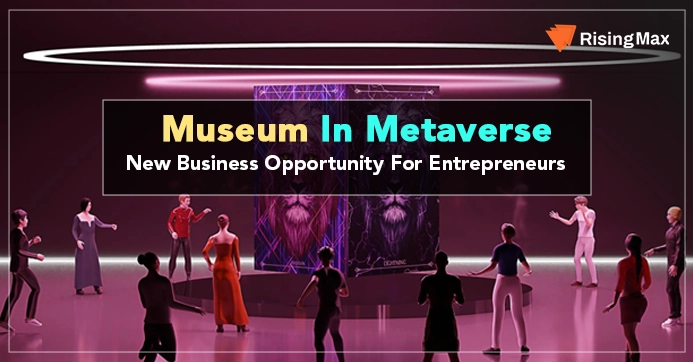World’s most-visited art museums saw a staggering 77% drop in visits in the year 2020, as revealed by the annual survey by The Art Newspaper. Although, the pandemic and frequent lockdowns were the real reason behind this low footfall.

It started a discussion among the art and cultural sector to look for alternate options for diversifying revenue streams. While searching for an alternative, museums worldwide need a solution that meets the growing demand for digital content to survive in the long term.
Therefore, setting up a museum in the metaverse or creating a digital replica becomes a futuristic alternative to widen its reach and diversify its revenue stream. While traditional museums showcase fine art, cultures, civilizations, history, and important inventions.
A museum in the metaverse allows visitors to see history and visualize the future in an immersive environment. Integration of next-gen technologies like AI, AR, VR, and 3D paves the path for museums to embrace unknown possibilities.
Are you planning to launch your own museum in metaverse? Then, reach out to our experts at RisingMax Inc. to discuss your idea. We have been providing metaverse development services for over half a decade now. From metaverse office setup to metaverse games, and e-commerce solutions, we offer a wide array of metaverse services as per our clientele needs. Schedule a FREE consultation call with our metaverse experts to discuss your museum in metaverse idea.
Let’s dig deep into the museum in metaverse and the unlimited possibilities with virtual museums. But first, let’s try to understand the virtual museum.
What Is A Virtual Museum?
A virtual museum can be a digital extension of a physical museum or a completely new virtual space for showcasing history and the future. These virtual spaces in the metaverse enable museums to meet the needs of GenZ and millennials; widening their reach in the virtual world. These virtual platforms are designed to showcase virtual content and can operate more like an auction house than a museum.
There are two types of virtual museums:
Museum Digital Twin:
A museum digital twin is a virtual extension of a physical museum. Building a museum digital twin in the metaverse enables museums to provide an alternative for visitors to view the cultures, civilizations, historical art, and sculpture virtually. Anyone from around the world can leverage new-age gadgets like AR & VR glasses to access these virtual platforms to visit the museums.
Metaverse Museums:
A museum in the metaverse is not a digital extension of a physical museum. These are virtual museums designed specifically to meet the needs of next-gen art lovers and redefine visitors’ experiences. These virtual platforms widen museum revenue generation options as they can operate like an auction house rather than a museum. Artists can leverage these platforms to showcase their digital work as NFTs and find potential buyers.
Both these types of virtual museums are extremely popular and effective ways for museums to widen revenue generation options and be future-ready.
Why Are Museums In The Metaverse Getting More Popular Than Traditional Ones?
Traditional museums have effectively handled the weight of showcasing history, cultures, and fine art on their shoulders for quite a longer duration. While traditional museums were designed to showcase collections, limited by physical space, they can only display a small percentage of their collection. Even though museums were the epicenter for people to take a look back in history, their incapability to provide access to larger historical collections and limited space left a space that traditional museums failed to fulfill.
The space among history lovers and traditional museums is effectively filled with setting up a virtual museum in the metaverse. With virtual museums in metaverse, there is no need to acquire an art collection permanently, and one can acquire art for a limited duration. Here are some key reasons why virtual museums are more popular than traditional ones:
No space limitation – While traditional museums have to find a perfect balance between the limited space and showcase of artwork. With virtual museums, there’s no need to worry about space limitations. Various artwork, cultures, and historical events can be displayed effectively to provide a complete overview without worrying about space limitations.
No need to permanently acquire artwork – Traditional museums need to acquire artwork or historical sculptures to showcase them to visitors. However, a museum in the metaverse skips the art-acquiring process and can host a digital art collection on a rotational basis.
Generate new revenue streams – Unlike traditional, virtual museums operate more like auction houses, thus generating a new revenue generation stream. Artists can leverage the popularity of these platforms to showcase their digital artwork as an NFT to potential buyers and sell them.
Enhanced experience – The virtual museums in the metaverse are integrated with next-gen technologies like IoT, AR, & VR to enhance visitors’ experience. With any IoT-powered device, people can visit these museums and enjoy an immersive environment while looking back on history.
More than anything, these virtual platforms can adapt to the digital hunger of the next generation while maintaining their intended purpose. Combining all the above-mentioned factors adds up to the popularity of virtual museums. Thus, making it inevitable for museums to look for answers for how to run museums in the metaverse.
Align the current state of IT with your business strategy by hiring the most trustworthy Metaverse Development Company
How To Run Museums In Metaverse?
Venturing into a new business requires a fair amount of knowledge and skills; running a museum in the metaverse is no different. To ease your struggle, we have suggested some tried and tested methods for you to run a museum in the metaverse that are bound to give you positive results. So, without much ado, let’s start with the first one;
Tokenizing collections
With the growing popularity of the metaverse, many proponents believe that this technology will take the museum world to a whole new level. Museums worldwide can tokenize their collections and recreate 3D images of their collections that can be viewed using AR and VR technology.
Integrate VR & AR
Integration of AR & VR technology empowers museums in the metaverse to provide an immersive experience to visitors. Visitors can use these platforms to go beyond museum tours and become effective tools for cultural engagement. The extended reach of virtual museums empowers them to overcome traditional barriers and become a connection among history enthusiasts worldwide.
Create a community
With the revolution of social media, these platforms have become an effective medium for like-minded people to engage in community. With the rise of the metaverse, proponents believe that it will open up a path for audiences to share their views and build communities openly. Active engagement of these communities will result in organizing virtual events like art auctions, thus adding up to platform popularity.
Gamifying museums
Gamification is a great tactic for museums to engage visitors and adds to their popularity. Museums in the metaverse can offer attractive digital rewards and other gamification initiatives to enhance the engagement rate and allow visitors to earn at the same time.
How Much Does Setting Up a Museum in Metaverse Cost?
Similar to any metaverse project, no single cost can be quoted for every project. Metaverse development services providers carefully evaluate the project’s details and cost-deriving before quoting a development estimation.
Major cost-driving factors in setting up a museum in metaverse:
- Type of virtual museum.
- Integrated features.
- Features complexity.
- In-built technologies like AR & VR.
- Security features.
- Location of metaverse development service provider.
- Metaverse project development team’s strength and expertise.
- Museum key add-on features.
Are you searching for an exact setting up cost of a museum in the metaverse? Then, reach out to our experts at RisingMax Inc. and discuss your metaverse project in detail. Our team, after carefully evaluating all the project cost-driving factors and development needs, will share a customized development cost for your project.
Most metaverse app development service providers in NYC, USA, charge an average of $80,000 cost of setting up a museum in the metaverse. However, the project development cost might go up based on the above cost-driving factors.

Why Choose RisingMax Inc. For Setting Up a Museum in Metaverse?
RisingMax Inc. is a top-rated metaverse development company in NYC, USA. Over the years, we have assisted clients in different business verticals to jump on the metaverse bandwagon and strengthen their digital footprint. Metaverse is still in its nascent stages. We empower businesses to swiftly adapt to the changing tech trends and move their existing business into the virtual world.
Here’s why you hire us;
- Unmatched metaverse expertise.
- Affordable metaverse development services.
- Tech prowess.
- Reliable and secure metaverse solutions.
- Certified and experienced metaverse development team.
- Transparent pricing policy.
- 24*7 customer support.
Let’s connect over a FREE consultation call and discuss your virtual museum idea with our experts TODAY!!











